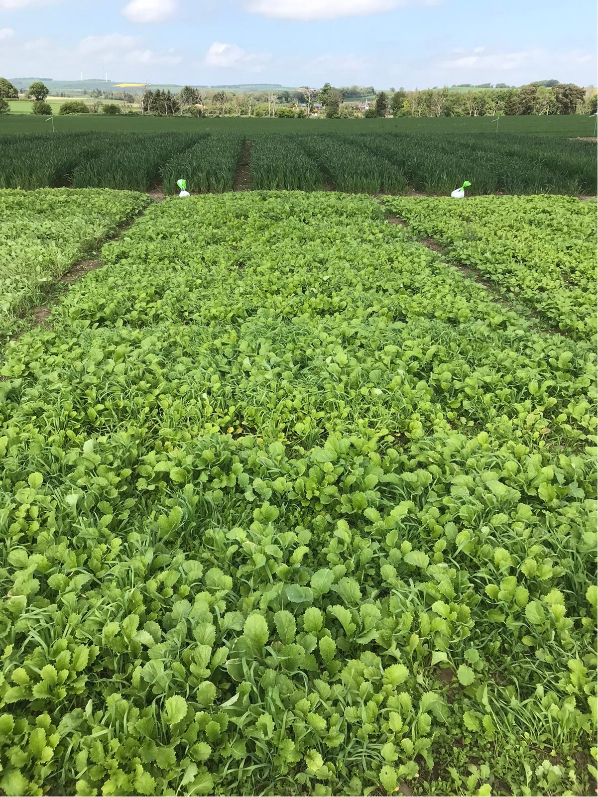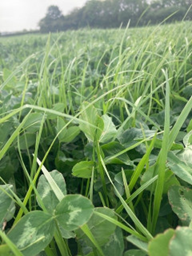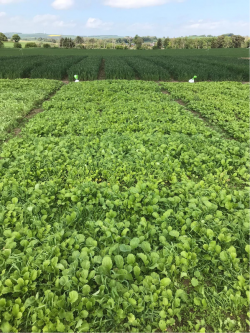Take the chance to boost your forage stocks this autumn
With the relentlessly wet harvest at an end for most - or very nearly at an end - thoughts have already turned towards new season crop establishment.
This time last year, following the very dry summer, many grappled with poor conditions for sowing grass and forage and as a result quite a lot of seed remained in the shed. Our colleague, Dave Harris, did a great blog earlier this year highlighting the value in reseeding grassland and investing into new leys.
Importantly, following the recent Sustainable Farming Incentive (SFI) updates from Defra, the option to sow herbal leys further lifts the value proposition of re-seeding tired pastures, with £382 per hectare available through the new SAM3 option. Similarly, planting eligible forage crops now could achieve payments of £129 per hectare through the SAM2 multi-species winter cover option, as recently highlighted by Kings midlands advisor, Anna Ramsay, in her blog about the value of winter cover.
The good news is that although the season is marching on this year's conditions are much more favourable, with good moisture and warm temperatures still offering a great starting point for those crops yet to be drilled - including forage. With that in mind, there's still time to seize the chance to boost your stocks this year, whether it is through grass or cover crops.
Grass and herbal leys
Forage grass is the most cost-effective forage solution and has long been a vital resource for all UK dairy, beef and sheep farmers. Well managed forage grass can provide large amounts of dry matter and valuable feed. To get the most from your crop, it's important to take the time to pick the right varieties and species to suit your conditions and farm system.
Despite the favourable conditions, we are probably getting too late now for establishing new herb-rich swards in most areas, but we would encourage you to consider them ahead of any spring re-drills you have planned. With the more extreme and changeable weather we are experiencing, herbal leys or herb-rich swards are demonstrating their value as more resilient pastures. Where we have experienced drought, the deep root structure of species like plantain, chicory and cocksfoot have ensured continued production.
Grass-only mixes are still an option at this time of year - whether you establish a new sward or overseed an existing one, both will help produce new grass growth which will respond well to fertiliser applications and spring growing conditions. Any new growth will ensure the cleanliness of your forage by out-competing any unwanted, less-productive species too.
For re-seeding scenarios in particular, species options are broader as grasses can grow under colder conditions. However, seedbed preparation is key to ensure you get the most from your mixture. If re-seeding an older ley that has been left for a number of years, the weed burden in the field may surprise you.
In terms of management, burning off the previous ley and it's weeds effectively is the best way to give your new mix the best start in life. You can get help and best practice advice on this from your qualified Frontier agronomist, who will also be able to assist with strategies for achieving a stale seedbed prior to grass drilling. Proper preparation can give your new ley an extra year, which can be a good insurance policy in case we see another season like that of 2022.
Your soil pH and nutrient status are important factors too, particularly if they have been stressed by an extended ley length due to last season. Soil is of all course key to all crops, but it can be an area sometimes overlooked with autumn fast approaching. Getting an accurate picture of soil pH and available nutrients is valuable – pennies spent managing the soil now can pay pounds in yield and liveweight gain in the spring.
The new SFI option 'NUM1' may be beneficial here, as funding is available for a nutrient management assessment. If you're unsure or would like more advice, speak to your Frontier or Kings contact.
Forage
Given the late harvest, drilling stubble turnips behind the combine isn't an option now, but luckily there are some alternatives:
- Post-harvest mixes
As covered in our colleague Anna's blog on the benefits of winter cover, cover crops are becoming an important part of many farm cropping systems due to the soil health and environmental benefits they provide. Frontier's sustainable crop production team is increasingly working with end consumers who are also showing an interest in cover crops for the same reasons too.
Further to the soil health benefits, cover crops can provide a valuable forage source through the autumn if you have livestock. Mixes that include brassicas offer the best grazing return if your rotation allows them.
Our Post-Maize Grazer Mix is a great all-rounder. Finding an option to follow maize can be a challenge, but as the name suggests it was designed for later drilling, with the turnip rape and forage rye offering strong growth vigour and subsequently good grazing return. The diversity of the root structures also delivers valuable benefits below ground, helping build soil structure and organic matter while improving nutrient capture.
- Westerwold
A fast-growing grass, Westerwold can also be sown straight after maize is harvested to capture residual nutrients, reduce nitrogen leaching and provide soil cover over the winter. When sown in the autumn, it will provide a bulky early spring bite to help extend the grazing window.
You can also consider a mixture of Westerwold and Italian ryegrass for even more forage value while maintaining rapid establishment. Our Kings Sprinter mixture, which is a 50:50 blend of both, is ideal if you're looking for a mix to follow maize with a little more longevity, as it's excellent for silage and hay cuts.
- Forage rye
We mentioned forage rye as part of our Post-Maize Grazer mix but to be honest, it's worth some spotlight of its own.
It is a great option at this time of year for both forage and cover cropping due to its early vigour and biomass production. It's fibrous root network also helps stabilise soils over winter while scavenging for nutrients in the soil, also producing around five-to-six tonnes per hectare of dry matter.
Our forage rye variety, Traktor, can be a reliable option - as a cereal it can be drilled later than a legume and its height in the spring can be a welcome surprise.
- Turnip rape
Although part of the aforementioned post maize grazing mix, this is another option that can bring notable benefits in its own right. Turnip rape is a Kings favourite for late-sown grazing potential, boasting high palatability despite having slightly hairy leaves. Sown at 8kg/ha and broadcast at 10kg/ha, our planetary variety Jupiter is a good option for September forage.
Act now to get the best results later
In summary, there is still time to bolster your forage supplies but the sooner you take action the better, as the window for sowing is closing.
Whether you are looking at grass or cover crops, make sure you pick the option that suits your establishment conditions as well as your forage goals.
If you have any questions or would like to discuss how you can maximise your farm's forage potential, please speak to your local Frontier or Kings contact You can also phone the free Kings technical helpline on 0800 587 9797 and find more detail about mix options in the Kings Catalogue.
As a subscriber, you’ll receive email alerts each time a new blog is published so you can always stay updated with the latest advice and insights from our experts










Comments